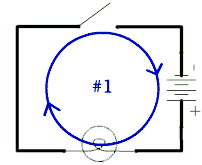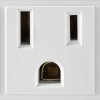Basic concepts of electricity
What are some important things to know about electricity?
- Conductors and insulators - Conductors are materials that allow electricity to flow easily. Most types of metal are good conductors, which is why we use metal for electrical wire. Copper is a good conductor and isn't too expensive, so it's used a lot for the wiring in homes today.
Insulators are the opposite of conductors. An insulator is a material that doesn't carry electricity. Insulators are important because they can protect us from electricity. Materials like rubber, plastic, and paper are good insulators. - Voltage - Voltage is the name for the electric force that causes electrons to flow. It's the measure of potential difference between two points in the circuit. Voltage may come from a battery or a power plant.
- Current - Current is the measure of the flow of electrons in a circuit. Current is measured in Amps or Amperes.
- Power (Watts) - The power or energy used by a circuit is measured in Watts. You can calculate the number of Watts by multiplying the Voltage times the Current. When your parents get their electrical bill it's generally in kilowatt hours. This is the measurement of power over time or how much power was used that month.
- Resistance - Resistance measures how well a material or object conducts electricity. Low resistance means the object conducts electricity well, high resistance means the object does not conduct electricity well.
A battery can act as a source of electricity in circuits. It stores up electric power and then provides a voltage across a circuit causing power to flow through the circuit.

Batteries use chemicals that react to produce electricity. They have a positive terminal called the cathode and a negative terminal called the anode. When a circuit with a load is placed across the anode and cathode, the chemicals react causing electricity to flow through the circuit. The chemicals in batteries only last so long, so batteries have a limited amount of electricity and eventually will run out.
Alternate and Direct Current
There are two main types of current used in electrical systems today: alternate current (AC) and direct current (DC). Batteries, and most electronics, use direct current. This is where current always flows in one direction. Power stations that generate power for our homes generate current that constantly changes direction (60 times each second). Therefore the power that we get from our wall outlets is AC current.
Static Electricity
Sometimes electric charges can build up on the surface of objects. This is called static electricity. When you put on your clothes and they sometimes "stick" to your body or have an attraction to you, this is static electricity. When your hair sometimes goes straight up for no reason, this can be static electricity. If you rub a balloon against your clothes, you can build up a static electricity charge on the balloon that will cause it to stick to a wall. Static electricity can sometimes damage electronic components. There are anti-static bags and other ways to protect components from getting damaged.

